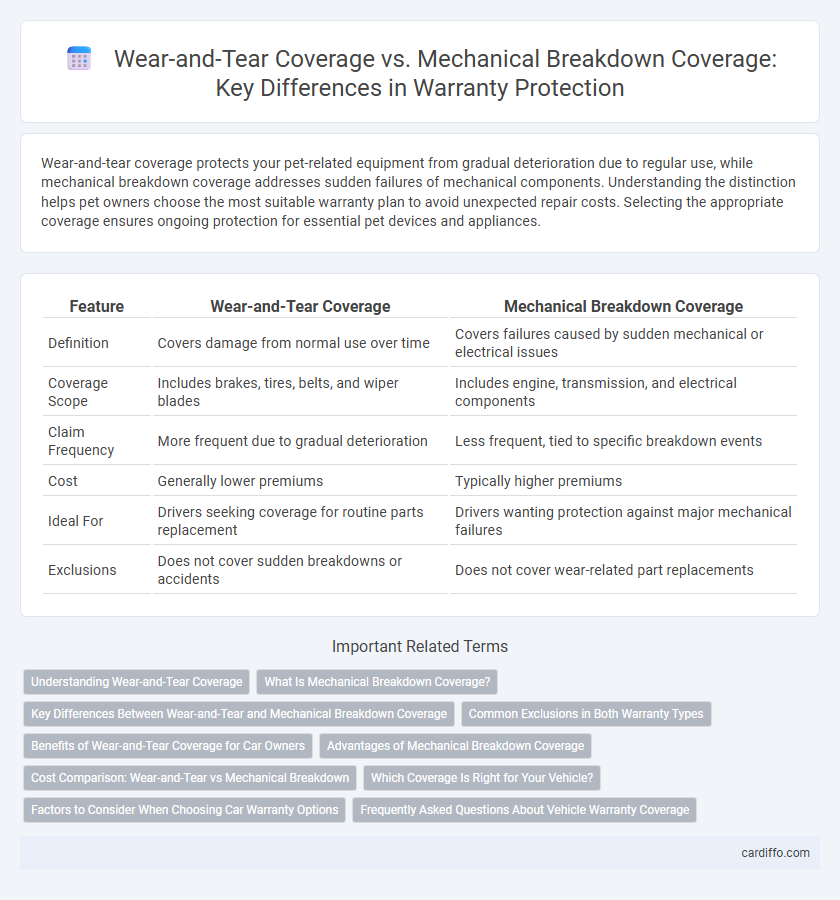Wear-and-tear coverage protects your pet-related equipment from gradual deterioration due to regular use, while mechanical breakdown coverage addresses sudden failures of mechanical components. Understanding the distinction helps pet owners choose the most suitable warranty plan to avoid unexpected repair costs. Selecting the appropriate coverage ensures ongoing protection for essential pet devices and appliances.
Table of Comparison
| Feature | Wear-and-Tear Coverage | Mechanical Breakdown Coverage |
|---|---|---|
| Definition | Covers damage from normal use over time | Covers failures caused by sudden mechanical or electrical issues |
| Coverage Scope | Includes brakes, tires, belts, and wiper blades | Includes engine, transmission, and electrical components |
| Claim Frequency | More frequent due to gradual deterioration | Less frequent, tied to specific breakdown events |
| Cost | Generally lower premiums | Typically higher premiums |
| Ideal For | Drivers seeking coverage for routine parts replacement | Drivers wanting protection against major mechanical failures |
| Exclusions | Does not cover sudden breakdowns or accidents | Does not cover wear-related part replacements |
Understanding Wear-and-Tear Coverage
Wear-and-tear coverage protects against the gradual deterioration of vehicle components due to regular use, covering parts like brake pads, tires, and wiper blades. This type of warranty addresses issues caused by normal aging rather than sudden mechanical failures. Understanding the specifics of wear-and-tear coverage helps vehicle owners manage repair costs for components that commonly require replacement over time.
What Is Mechanical Breakdown Coverage?
Mechanical breakdown coverage protects against the repair costs of a vehicle's internal components such as the engine, transmission, and electrical systems when they fail due to normal use or defects, excluding damage from accidents or wear and tear. This warranty typically covers major mechanical failures and offers peace of mind for expensive repairs that are not caused by regular maintenance issues. It differs from wear-and-tear coverage by specifically addressing component breakdowns rather than gradual deterioration over time.
Key Differences Between Wear-and-Tear and Mechanical Breakdown Coverage
Wear-and-tear coverage protects against gradual deterioration of components due to normal use, such as brake pads, tires, and clutch assemblies, while mechanical breakdown coverage covers sudden and unexpected failures of major mechanical parts like the engine, transmission, and electrical systems. Wear-and-tear coverage typically includes routine maintenance elements and consumable parts, whereas mechanical breakdown coverage excludes maintenance and focuses on repairing defects or malfunctions. Understanding these distinctions helps consumers choose the appropriate protection based on their vehicle's age, condition, and driving habits.
Common Exclusions in Both Warranty Types
Common exclusions in both wear-and-tear and mechanical breakdown coverage typically include damage caused by accidents, neglect, or improper maintenance. Items like tires, brake pads, and clutch assemblies are often excluded due to their regular replacement nature. Additionally, coverage rarely applies to cosmetic damage or failures resulting from modifications or unauthorized repairs.
Benefits of Wear-and-Tear Coverage for Car Owners
Wear-and-tear coverage provides car owners with protection against the gradual deterioration of vehicle components due to normal usage, minimizing unexpected repair costs over time. This type of coverage typically includes high-impact parts like brakes, tires, and suspension systems, offering comprehensive maintenance support beyond major mechanical failures. By addressing routine wear, wear-and-tear coverage helps maintain vehicle reliability and enhances long-term resale value.
Advantages of Mechanical Breakdown Coverage
Mechanical Breakdown Coverage offers comprehensive protection for a wide range of vehicle components beyond normal wear and tear, including the engine, transmission, and electrical systems, reducing expensive repair costs. This coverage is ideal for owners of newer vehicles or those seeking to protect major mechanical failures that are typically excluded from Wear-and-Tear policies. It provides peace of mind by covering unexpected breakdowns, ensuring reliability and financial savings over time.
Cost Comparison: Wear-and-Tear vs Mechanical Breakdown
Wear-and-tear coverage typically involves higher premium costs compared to mechanical breakdown coverage due to the broader scope of repairs, including cosmetic and non-essential parts. Mechanical breakdown coverage generally focuses on essential components like the engine and transmission, resulting in lower premiums but potentially higher out-of-pocket expenses for non-covered items. Consumers should evaluate the cost-effectiveness based on vehicle age, usage patterns, and potential repair risks to select the most suitable warranty option.
Which Coverage Is Right for Your Vehicle?
Wear-and-tear coverage protects against the gradual deterioration of vehicle components due to normal use, ideal for high-mileage or older cars prone to frequent maintenance. Mechanical breakdown coverage addresses sudden failures of major mechanical systems, making it suitable for newer vehicles or those with little existing damage. Choosing the right coverage depends on your vehicle's age, mileage, and overall condition to ensure optimal protection and cost-efficiency.
Factors to Consider When Choosing Car Warranty Options
Wear-and-tear coverage protects against gradual deterioration of components like brake pads and tires, while mechanical breakdown coverage covers unexpected failures in major systems such as the engine and transmission. Consider factors like the vehicle's age, mileage, and maintenance history to determine which coverage aligns with your risk profile and budget. Evaluate warranty terms, coverage limits, and deductibles to ensure optimal protection tailored to your car's condition and driving habits.
Frequently Asked Questions About Vehicle Warranty Coverage
Wear-and-tear coverage protects against the gradual deterioration of components such as brake pads, tires, and wiper blades, whereas mechanical breakdown coverage typically covers unexpected failures of essential systems like the engine, transmission, and electrical components. Vehicle warranty FAQs often address the distinction between these coverages, highlighting that wear-and-tear is usually excluded from manufacturer warranties but may be included in extended warranties. Understanding which parts and types of damage are covered helps vehicle owners make informed decisions about purchasing additional warranty protection.
Wear-and-Tear Coverage vs Mechanical Breakdown Coverage Infographic

 cardiffo.com
cardiffo.com